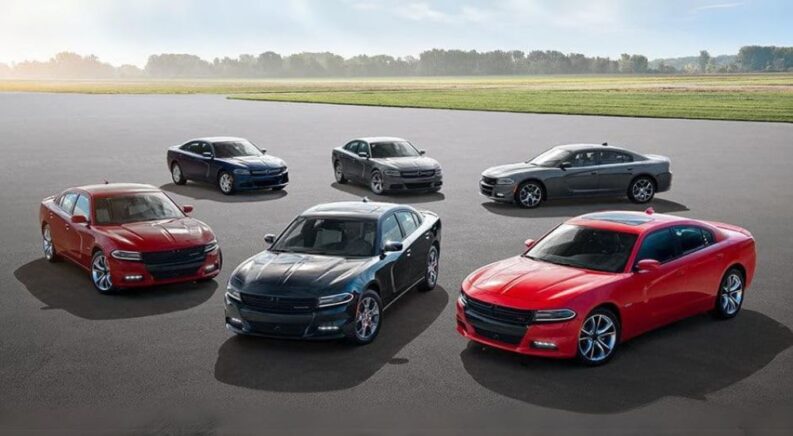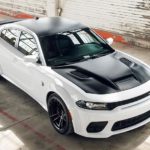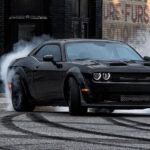Reports of the Dodge Charger’s demise have been greatly exaggerated. In late 2022, Stellanis announced that the iconic muscle car would be consigned to used Dodge dealerships to make way for a new generation of all-electric models, but just two years later, Dodge is already ready to welcome the gas-powered Charger back to the lineup. To be fair, it was unlikely that the Charger was ever really gone for good. Even when announcing the discontinuation, Dodge dropped some hints that an all-electric version could be on the way in the near future. That came to pass late last year as Dodge unveiled the 2024 Charger Daytona EV, but we certainly weren’t expecting it to be joined by a traditional internal combustion version quite so soon.
The resurrected Charger—and its new EV counterpart—looks to continue a legacy of muscle car performance that stretches back more than 50 years. While we wait to get our hands on the new 2025 model, we thought it would be a great time to look back on the model’s history and see how Dodge has managed to keep the Charger fresh throughout the decades. From the original Dodge Coronet-based version to the 807 hp Jailbreak Edition that represented the Charger’s (supposed) swan song back in 2022 and today’s revived Charger and Charger Daytona models, join us as we see how the famed muscle car has evolved with the times.
First Generation: 1966–1967
It’s the late 1960s, and pony cars are all the rage. The youth-oriented segment burst onto the scene in 1964 when the Plymouth Barracuda hit the market, though much of the early excitement (as well as the segment’s equine-inspired name) can be credited to Ford’s Mustang, which would be released two weeks after the Barracuda. No matter who was first, there was no denying the impact these early pony cars had on the industry as a whole, and Dodge wanted a part of it.
While it might have followed in the general pony car mold, the Charger was also intended to be a little different. Pony cars were known for their diminutive size and affordability, but Dodge anticipated the demand for a larger, more upscale alternative that would serve the rapidly expanding specialty car market. Aimed at a more mature set of drivers, the Charger was designed to merge the fun and style of a pony car with the sorts of features and dimensions that would attract a driver more focused on their daily commute than their Friday night plans.
Dodge already had a well-regarded midsize offering in the Coronet, so the sportier Charger was simply introduced as a new fastback version. While the Charger embraced the classic long-nose and short-deck pony car design, Dodge designers threw some unique features into the mix to help set the coupe apart, such as full-width tail lights and front headlights that emerged from behind the grill. The Charger was also notably larger than many of its pony car competitors—22 inches longer compared to the Mustang—a factor that necessitated a larger engine than the four and six-cylinder setups found in other pony cars. With a variety of HEMI V8 engines to choose from, the first-generation Charger certainly wasn’t hurting for power.
Second Generation: 1968–1970
The Charger truly came into its own in its second generation thanks to some important updates that helped land the muscle car more than one starring role on the small screen. The Charger continued to embrace the “bigger is better” ethos, growing by over four inches, but welcomed a new 3.7-liter I-6 to the existing lineup of V8 offerings.
Dodge also took to the wind tunnel to give the second-gen Charger a curvier, more aerodynamic appearance but made sure to retain those unique features that had made the coupe such a hit the first time around. This aerodynamic design also led to plenty of success on the NASCAR circuit after Dodge introduced the Charger 500, a track-ready version of the Charger that featured a redesigned rear window and a grille borrowed from the Coronet that helped to reduce lift on the notorious banked turns of NASCAR tracks. The Charger 500 paved the way for the original Charger Daytona, which helped driver Bobby Issac take home the 1970 championship.
Stock car success aside, it was the second-gen Charger’s star turn on “Bullitt” and “The Dukes of Hazzard” that really made the model into an icon. Those questioning the benefits of a little product placement need look no further than the Charger’s sales: while Dodge originally planned to produce 35,000 units, the factory would turn out some 96,000-plus Chargers before the second generation came to an end in 1970.
Third Generation: 1971–1974
If the second-generation Charger represented the muscle car’s high point, the third-generation is when it came back down to Earth. Don’t blame Dodge for the descent: tightening emissions standards meant that the automaker had to sacrifice a little style and performance in the name of efficiency. Dodge shrunk the Charger for the first time, reducing the wheelbase by two inches and performing a number of styling tweaks in the name of aerodynamics. The Charger took on a more flowing design and was graced with a new grille, optional exposed headlights, and a new semi-fastback rear window that flowed into a deck lid with a ducktail spoiler. Dodge also ditched the HEMI, though several V8 options were still available alongside the base 3.7-liter I-6.
Charger sales continued to surge owing largely to the reputation of the second-gen model and the fact that Dodge eliminated the two-door Coronet around the same time. This meant that drivers seeking a midsize option had only Charger models to choose from, though there was still plenty of variety between the Charger 500, R/T, and SE. That said, the third-gen Charger 500 was a far cry from the NASCAR-dominating second-gen version, presenting itself more as a sporty appearance package than a bonafide racer.
Fourth Generation: 1975–1978
For better or worse, the fourth-gen Charger is a time capsule of 1970s design. Dodge looked to create a more upscale version of the muscle car to cater to the growing demand for luxury models, but it doesn’t exactly stand the test of time unless you’re a big fan of bulky hood ornaments, wood paneling, and faux-convertible vinyl tops. The headlamps, grille, and roofline were all restyled, but the most notable change could be found under the hood, where Dodge bucked the growing efficiency trend to provide three V8 options. That would prove to be a less-than-fortuitous decision for the brand, which temporarily ceased Charger production following the 1978 model year.
Fifth Generation: 1982–1987
A new decade brought a whole new approach when it came to the Charger. Dodge ditched the classic design, reimagining the Charger as a front-wheel drive compact liftback coupe. Built on Dodge’s Omni economy car platform, the fifth-gen Charger’s racing days were obviously well behind it when you factored in the 1.6-liter or 2.2-liter inline-four engines that maxed out at 84 hp. Luckily, racing and automotive design legend Caroll Shelby came to the rescue, tweaking the 2.2-liter I-4 to produce 107 hp.
The Dodge Shelby Charger also came with sport-tuned shocks and springs, new tires, sportier bodywork, and redesigned gas and brake pedals that allowed for heel-toe shifts. A later version, the 1985 Dodge Shelby Turbo Charger, would add a turbocharger to the mix to give drivers 174 hp to play with, helping the subcompact to relieve its muscle car glory days with an impressive power-to-weight ratio. The fifth generation might not have marked the Charger’s heyday, but Shelby’s involvement helped to keep the nameplate relevant in a rapidly evolving market.
Sixth Generation: 2006–2010
Buoyed by the success of the front-engine, rear-wheel drive Dodge Magnum and Chrysler 300—the latter of which earned a prestigious 2005 MotorTrend Car of the Year award—Dodge decided to reintroduce the Charger after an almost 20-year hiatus. The Charger returned to its muscle car roots, leaving its regrettable compact days behind to emerge as a full-size, four-door sedan. Dodge infused the Charger with some bold new styling that included a crosshair grille and deliriously curvy body while packing it with enough power to do the Charger name proud.
The sixth-gen Charger came standard with a 250 hp V6 engine and saw the return of the 5.7-liter HEMI V8 for the R/T trim. Designed with upsized brakes, 18-inch wheels, and dual exhaust outlets, the R/T certainly put an emphasis on performance but was soon outdone by the SRT8 trim powered by a 425 hp 6.1-liter HEMI V8. Dodge also packed the sixth-gen model with a satisfying list of luxury features as part of the SXT package, which included a power driver’s seat, a 276-watt Boston Acoustics sound system, and a leather-wrapped steering wheel. It was a return to form for the Charger, starting a trend that would persist through the muscle car’s coming generations.
Seventh Generation: 2011–2023
The Charger has long prioritized power, but that trend certainly reached a high point in the model’s seventh generation. This is when Dodge really started pulling out all the stops, fitting the Charger with some of the most unhinged engines in the muscle car’s history to produce models bearing names like the SRT Hellcat, SRT Hellcat Redeye, and SRT Hellcat Jailbreak Edition. With a design inspired by the beloved second-gen Charger, the seventh-gen Charger featured wraparound LED taillights, new side scoops on the front and rear doors, and angled headlights that gave the muscle car a sinister, aggressive look. These changes were not just intended to improve the Charger’s style and performance; they also went a long way toward increasing visibility, which was a common driver complaint on the sixth-gen version. The Charger would get a little refresh in 2015, which saw the addition of LED headlights and a new, more aerodynamic nose, as well as upgrades to the suspension, interior, and brakes.
Originally powered by a 292 hp 3.6-liter Pentastar V6, a 370 hp 5.7-liter HEMI V8, or a 470 hp 6.4-liter HEMI V8, it was the 2015 refresh that added the 6.2-liter Hellcat V8 that would really put the new Charger on the map. With 707 hp to its name, the Charger SRT Hellcat could speed from zero to 60 mph in just 3.7 seconds. Dodge would manage to improve on that in 2021 when the Charger SRT Hellcat Redeye hit the streets, churning out 797 hp and posting a top speed of 205 mph. The widebody SRT Hellcat Redeye was built to accommodate an upgraded tire and suspension package, making the muscle car one of the most track-ready models to date. Finally, there’s the 2022 Charger SRT Hellcat Jailbreak Edition, which added 10 ponies to the mix to produce the most powerful version to date at 807 hp. Complete with racing stripes and brake calipers, wheels, badges, and exhaust tips that could be ordered in a number of customized colors, the Charger SRT Hellcat Jailbreak Edition was a fitting farewell for the famed muscle car…or so we thought.
2024 Charger Daytona
While some muscle car traditionalists will need to be won over, the Charger Daytona EV might just be one of the most exciting models to date. The Daytona leverages all the advantages of EV design to offer scintillating acceleration and a host of high-tech goodies like a heads-up display, a PowerShot button that can provide a 15-second 40 hp boost, and a Drive Experience Recorder that allows drivers to catalog their in-vehicle antics complete with audio, video and vehicle data. The muscular EV also includes some modern takes on classic Charger features, including a “pistol grip” shifter and a Fratzonic electronic exhaust system that pays homage to Dodge’s historic Fratzog logo.
The Daytona EV will hit the market as a two-door model, but Dodge plans to add a four-door version to the lineup for 2025. This makes the muscle car a more practical choice for those looking to use their EV as a daily driver. The eight-generation model is also larger than ever and incorporates a liftback design like the fifth generation, offering 133 percent more cargo volume than the seventh-generation Charger.
But the Charger Daytona EV is no practical cargo hauler. Packed with a 100.5 kWh battery and two electric motors, the entry-level Daytona R/T trim pumps out 496 hp, while the Scat Pack version maxes out around 670 hp—good enough for a claimed zero to 60 mph time of 3.3 seconds. The Daytona EV also comes with a long list of optional features, including a Track Package with Goodyear Eagle F1 Supercar 3 tires, a 16-inch digital instrument cluster, and various drive modes that range from Donut mode to Drift mode.
2025 Charger Sixpack
In addition to the electric Charger Daytona, the gas-powered Charger is returning to the Dodge lineup for 2025. Sure, it isn’t really much of a wait, with Dodge ultimately just skipping over one model year, but it probably feels like an eternity for some longtime disciples of the legendary muscle car. Dodge is improving on almost every aspect of the proven Charger formula for 2025. The real headline would have to be the new body style: while the Charger has long provided a four-door alternative to the two-door Challenger, that all changes in 2025 as the automaker rolls out a new fastback coupe version.
Fans of the Charger’s renowned HEMI V8 will be sad to learn that the engine didn’t make the jump to the 2025 model, but the power of forced induction more than makes up for the missing cylinders with a twin-turbo Hurricane I-6 mated to a standard all-wheel drive powertrain and eight-speed automatic transmission. The all-new Charger will be available with two versions of this engine to start—the Standard Output Hurricane I-6 at 420 hp and the High Output Hurricane I-6 with 550 hp—but expect a wide range of performance-minded options like the Scat Pack and R/T to follow.
Drivers will have to wait until 2025 to get their hands on the revived Charger, but it should be well worth the wait. Like the all-electric Charger Daytona, the internal combustion version is packed with a host of modern comfort, convenience, and tech features, including a 12.3-inch infotainment screen, adjustable ambient lighting, Amazon Alexa voice assistant, and the choice of premium stereo systems from Alpine. The Charger also comes packed with all the advanced driver assistance systems one would expect for a 2025 model, including adaptive cruise control, lane-keeping assist, and traffic sign recognition.
A New Era of Muscle
While sticking to a well-worn path is always a safe bet, the Charger has managed to find success by blazing its own trail. This strategy stretches back to the very first generation in 1966 when Dodge decided to buck the established pony car formula to create a more luxurious, roomier alternative to the current fad. The Charger would become an overnight sensation thanks in no small part to its TV fame, but it’s the model’s performance and ability to adapt to a changing market that really sets it apart. Sure, there have been some rather forgettable models tossed in there as well—we’re looking at you, fifth generation—but by and large, the Charger has managed to remain a relevant and exciting option for more than 50 years. While we were saddened to see the Charger’s run come to an end, it seems like we got a little ahead of ourselves with both an all-electric and gas-powered model set to carry the Charger nameplate into the future. While these models mark a new era for the muscle car, we’re confident that they will live up to the high bar set by the previous seven generations.





